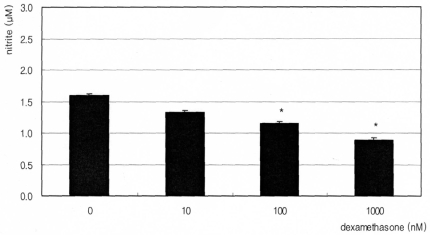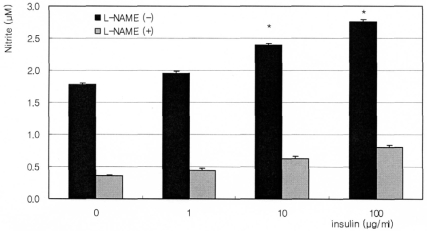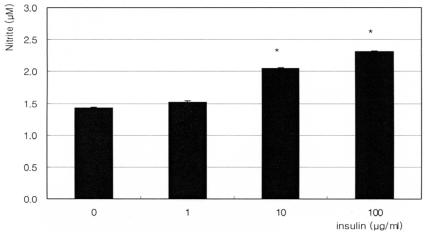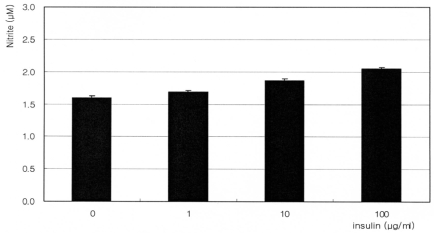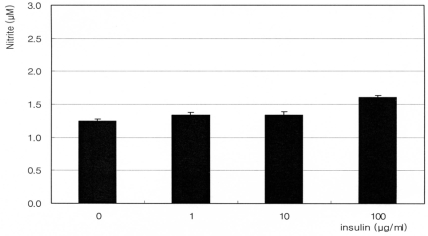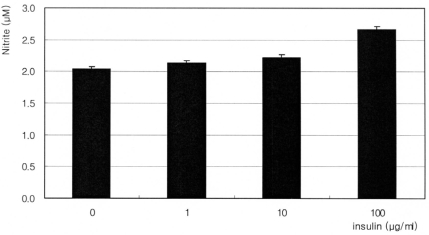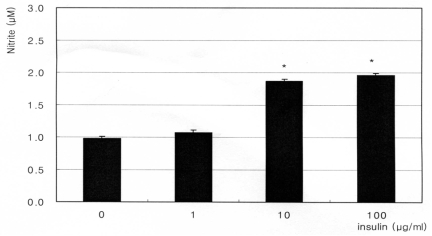Korean J Ophthalmol.
2007 Mar;21(1):39-44. 10.3341/kjo.2007.21.1.39.
Insulin Enhances Nitric Oxide Production in Trabecular Meshwork Cells via De Novo Pathway for Tetrahydrobiopterin Synthesis
- Affiliations
-
- 1Department of Ophthalmology, Catholic University of Daegu College of Medicine, Daegu, Korea. jwkim@cu.ac.kr
- KMID: 1105029
- DOI: http://doi.org/10.3341/kjo.2007.21.1.39
Abstract
- PURPOSE: To investigate the effect of insulin on the production of nitric oxide (NO) in the trabecular meshwork (TM) cells and the enzymatic synthetic pathway of tetrahydrobiopterin (BH4) synthesis. METHODS: Primarily cultured human TM cells were exposed to 1, 10, and 100 microgram/ml of insulin and 0, 1, 10, 100 and 1000 nM dexamethasone for 3 days. To evaluate the enzymatic pathway of BH4 synthesis, 10 micrometer dexamethasone, 5 mM diaminopyrimidinone, 100 micrometer ascorbic acid, 100 micrometer sepiapterin, or 10 micrometer methotrexate were also co-administered respectively. Cellular survival and NO production were measured with MTT and Griess assay. RESULTS: Insulin enhanced NO production in a dose-dependent manner significantly (p<0.05) without affecting cell viability, whereas dexamethasone inhibited NO production. With co-exposure of insulin, diaminopyrimidinone and sepiapterin inhibited insulin-induced NO production. Ascorbic acid increased NO production independent of insulin and methotrexate did not affect to the action of insulin in NO production. CONCLUSIONS: Insulin increases NO production in TM cells via de novo synthetic pathway for BH4 synthesis. Insulin could be involved in the regulation of trabecular outflow by enhancing NO production in TM cells.
MeSH Terms
Figure
Reference
-
1. Moncada S, Palmer RMJ, Higgs EA. Nitric oxide: physiology, pathophysiology, and pharmacology. Pharmacol Rev. 1991; 43:109–142. PMID: 1852778.2. Bredt DS, Snyder SH. Nitric oxide: a physiologic messenger molecule. Annu Rev Biochem. 1994; 63:175–195. PMID: 7526779.
Article3. Becquet F, Courtois Y, Goureau O. Nitric oxide in the eye: multifaceted roles and diverse outcomes. Surv Ophthalmol. 1997; 42:71–82. PMID: 9265703.
Article4. Nathanson JA, McKee M. Identification of an extensive system of nitric oxide-producing cells in the ciliary muscle and outflow pathway. Invest Ophthalmol Vis Sci. 1995; 36:1765–1773. PMID: 7543462.5. Geyer O, Podos SM, Mittag T. Nitric oxide synthase activity in tissues of the bovine eyes. Graefes Arch Clin Exp Ophthalmol. 1997; 235:786–793. PMID: 9439972.6. Meyer P, Champion C, Schlotzer-Schrehardt U, et al. Localization of nitric oxide synthase isoforms in porcine ocular tissues. Curr Eye Res. 1999; 18:375–380. PMID: 10373000.
Article7. Schuman JS, Erickson K, Nathanson JA. Nitrovasodilator effects on intraocular pressure and ocular facility in monkeys. Exp Eye Res. 1994; 58:99–105. PMID: 8157106.8. Wana RF, Podos SM. Effect of the topical application of nitroglycerin on intraocular pressure in normal and glaucomatous monkeys. Exp Eye Res. 1995; 60:337–339. PMID: 7789414.9. Nathanson JA, McKee M. Alteration of ocular nitric oxide synthase in human glaucoma. Invest Ophthalmol Vis Sci. 1995; 36:1774–1784. PMID: 7543463.10. Matsuo T. Basic nitric oxide production is enhanced by hydraulic pressure in cultured human trabecular cells. Br J Ophthalmol. 2000; 84:631–635. PMID: 10837391.11. Brodsky SV, Morrishow AM, Dharia N, et al. Glucose scavenging of nitric oxide. Am J Physiol Renal Physiol. 2001; 280:F480–F486. PMID: 11181410.
Article12. Kimura C, Oike M, Koyama T, et al. Impairment of endothelial nitric oxide production by acute glucose overload. Am J Physiol Endocrinol Metab. 2001; 280:E171–E178. PMID: 11120671.
Article13. Ding Y, Vaziri ND, Coulson R, et al. Effects of simulated hyperglycemia, insulin, and glucagons on endothelial nitric oxide synthase expression. Am J Physiol Endocrinol Metab. 2000; 279:E11–E17. PMID: 10893317.14. Du XL, Edelstein D, Dimmeler S, et al. Hyperglycemia inhibits endothelial nitric oxide synthase activity by posttranslational modification at the Akt site. J Clin Invest. 2001; 198:1341–1348. PMID: 11696579.
Article15. Scherrer U, Randin D, Vollenweider P, et al. Nitric oxide release accounts for insulin's vascular effects in humans. J Clin Invest. 1994; 94:2511–2515. PMID: 7989610.
Article16. Steinberg HO, Brechtel G, Johnson A, et al. Insulin-mediated skeletal muscle vasodilation is nitric oxide dependent. A novel action of insulin to increase nitric oxide release. J Clin Invest. 1994; 94:1172–1174. PMID: 8083357.
Article17. Zeng G, Quon MJ. Insulin-stimulated production of nitric oxide is inhibited by Wortmannin. Direct measurement in vascular endothelial cells. J Clin Invest. 1996; 98:894–898. PMID: 8770859.
Article18. Polansky JR, Weinreb RN, Baxter JD, et al. Human trabecular cells I. Establishment in tissue culture and growth characteristics. Invest Ophthalmol Vis Sci. 1979; 18:1043–1049. PMID: 383640.19. Polansky JR, Wood IS, Maglio MT, et al. Trabecular meshwork cell culture in glaucoma research: Evaluation of biological activity and structural properties of human trabecular meshwork cells in vitro. Ophthalmology. 1984; 91:580–595. PMID: 6540429.20. Kahler CM, Heroid M, Reinisch N, et al. Interaction of substance P with epidermal growth factor and fibroblast growth factor in cyclooxygenase-dependent proliferation of human skin fibroblasts. J Cell Physiol. 1996; 166:601–608. PMID: 8600164.21. Gomm JJ, Coope RC, Browne PJ, et al. Separated human breast epithelial and myoepithelial cells have different growth factor requirements in vitro but can reconstitute normal breast lobuloalveolar structure. J Cell Physiol. 1997; 171:11–19. PMID: 9119887.
Article22. Green LC, Wagner DA, Glogowski J, et al. Analysis of Nitrate, Nitrite and [15N]Nitrate in biologic fluids. Anal Biochem. 1982; 126:131–138. PMID: 7181105.23. Haefliger IO, Dettmann E, Liu R, et al. Potential role of nitric oxide and endothelin in the pathogenesis of glaucoma. Surv Ophthalmol. 1999; 43:S51–S58. PMID: 10416747.
Article24. Emre M, Orgül S, Shaw SG, et al. Increased plasma endothelin-1 levels in patients with progressive open angle glaucoma. Br J Ophthalmol. 2005; 89:60–63. PMID: 15615748.
Article25. Becker B. Topical 8-bromo-cyclic GMP lowers intraocular pressure. Invest Ophthalmol Vis Sci. 1990; 31:1647–1649. PMID: 2167302.26. Nathanson JA. Nitrovasidilators as a new class of ocular hypotensive agents. J Pharmacol Exp Ther. 1991; 260:956–965. PMID: 1532035.27. Wiederholt M, Sturm A, Lepple-Wienhues A. Relaxation of trabecular meshwork and ciliary muscle by release of nitric oxide. Invest Ophthalmol Vis Sci. 1994; 35:2515–2520. PMID: 7512945.28. Francine FB-C, Oliver G, Francois D'H, et al. Decreased intraocular pressure induced by nitric oxide donors is correlated to nitrite production in the rabbit eye. Invest Ophthalmol Vis Sci. 1996; 37:1711–1715. PMID: 8675417.29. Kojima S, Sugiyama T, Shimizu K, et al. Effect of a nitric oxide donor on intraocular pressure. Nippon Ganka Gakkai Zasshi. 1996; 100:181–186. PMID: 8900581.30. Schneemann A, Dijkstra BG, van den Berg TJ, et al. Nitric oxide/guanylate cyclase pathways and flow in anterior segment perfusion. Graefes Arch Clin Exp Ophthalmol. 2002; 240:936–941. PMID: 12486517.
Article31. Davies PD, Duncan G, Pynsent PB, et al. Aqueous humour glucose concentration in cataract patients and it effect on lens. Exp Eye Res. 1984; 39:605–609. PMID: 6519197.32. Park JY, Takahara N, Gabriele A, et al. Unduction of endothelin-1 expression by glucose An effect of protein kinase C activation. Diabetes. 2000; 49:1239–1248. PMID: 10909984.33. Cardillo C, Campia U, Bryant MB, et al. Increased activity of endogenous endothelin in patients with type II diabetes mellitus. Circulation. 2002; 106:1783–1787. PMID: 12356630.
Article34. Alp NJ, Channon KM. Regulation of endothelial nitric oxide synthase by tetrahydrobiopterin in vascular disease. Arterioscler Thromb Vasc Biol. 2004; 24:413–420. PMID: 14656731.
Article35. Gross SS, Levi R. Tetrahydrobiopterin synthesis. An absolute requirement for cytokine-induced intric oxide generation by vascular smooth muscle. J Biol Chem. 1991; 36:25722–25729.36. Heller R, Munscher-Pailug F, Grabner R, et al. L-ascorbic acid potentiates nitric oxide synthesis in endothelial cells. J Biol Chem. 1999; 274:8254–8260. PMID: 10075731.
Article37. Huang A, Vita JA, Venema RC, et al. Ascorbic acid enhances endothelial nitric-oxide synthase activity by increasing intracellular tetrahydrobiopterin. J Biol Chem. 2000; 275:17399–17496. PMID: 10749876.
Article38. Heller R, Unbehaun A, Schnellenberg B, et al. L-ascorbic acid potentiates endothelial nitric oxide synthesis via a chemical stabilization of tetrahydrobiopterin. J Biol Chem. 2001; 276:40–47. PMID: 11022034.
Article39. Chiou GCY. Review: effects of nitric oxide on eye disease and their treatment. J Ocul Pharmaco Ther. 2001; 17:189–198.40. Ferreira SM, Lerner SF, Brunzini R, et al. Oxidative stress markers in aqueous humor of glaucoma patients. Am J Ophthalmol. 2004; 137:62–69. PMID: 14700645.
Article41. Yildirim O, Ates NA, Ercan B, et al. Role of oxidative stress enzymes in open-angle glaucoma. Eye. 2005; 19:580–583. PMID: 15332106.
Article42. Izzotti A, Sacca SC, Cartiglia C, et al. Oxidative deoxyribonucleic acid damage in the eyes of glaucoma patients. Am J Med. 2003; 114:638–646. PMID: 12798451.
Article43. Sacca S, Pascotto A, Camicione P, et al. Oxidative DNA damage in human trabecular meshwork. Arch Ophthalmol. 2005; 123:458–463. PMID: 15824217.44. Sacca S. Nitric oxide as a mediator of glaucoma pathogenesis. Med Sci Monit. 2002; 8:LE33–LE34. PMID: 12233710.45. Gabelt BT, Kaufman PL. Changes in aqueous humor dynamics with age and glaucoma. Prog Retin Eye Res. 2005; 24:612–637. PMID: 15919228.
Article46. Liton PB, Challa P, Stinnett S, et al. Cellular senescence in the glaucomatous outflow pathway. Exp Gerontol. 2005; 40:745–748. PMID: 16051457.
Article47. von Zglinicki T. Oxidative stress shortens telomeres. Trends Biochem Sci. 2002; 27:339–344. PMID: 12114022.
Article48. Kurz DJ, Decary S, Hong Y, et al. Chronic oxidative stress compromises telomere integrity and accelerates the onset of senescence in human endothelial cells. J Cell Sci. 2004; 117:2417–2426. PMID: 15126641.
Article49. Blazer S, Khankin E, Segev Y, et al. High glucose-induced replicative senescence: point of no return and effect on telomerase. Biochem Biophy Res Comm. 2002; 296:93–101.50. Vasa M, Breitchopf K, Zeiher AM, et al. NO activates telomerases and delays endothelial cell senescence. Circ Res. 2000; 87:540–542. PMID: 11009557.
- Full Text Links
- Actions
-
Cited
- CITED
-
- Close
- Share
- Similar articles
-
- Effect of Dexamethasone on the Production of Nitric Oxide in Trabecular Meshwork Cells
- A Study of the Pathway of Nitric Oxide Production by Nitroglycerin in Trabecular Meshwork Cells
- Effect of Mitomycin C on the Proliferation and Nitric Oxide Production in the Cultured Trabecular Meshwork Cells
- Effect of beta-adrenergics on the Survival and Production of Nitric Oxide in the Cultured Trabecular Meshwork Cells
- Effect of Erythropoietin on the Production of Nitric Oxide in Trabecular Meshwork Cells

